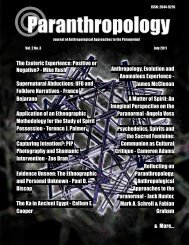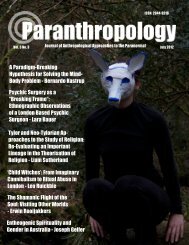Psi and Psychedelics - Paranthropology - Weebly
Psi and Psychedelics - Paranthropology - Weebly
Psi and Psychedelics - Paranthropology - Weebly
You also want an ePaper? Increase the reach of your titles
YUMPU automatically turns print PDFs into web optimized ePapers that Google loves.
Putting the <strong>Psi</strong> Back Into Psychedelic Research<br />
PARANTHROPOLOGY: JOURNAL OF ANTHROPOLOGICAL APPROACHES TO THE PARANORMAL VOL. 2 NO. 2<br />
they could conduct their research more easily. By 1952, after some further<br />
experimentation, Osmond <strong>and</strong> Smythies published an article in the Hibbert<br />
Journal proposing that a new theory of mind was needed that could account<br />
for the extraordinary experiences that occur with mescaline <strong>and</strong> what they<br />
considered to be the scientifically proven fact of ESP. The English novelist<br />
Aldous Huxley read the article <strong>and</strong> requested that Osmond should visit<br />
Huxley in the United States <strong>and</strong> give him mescaline (see Stevens, 1988).<br />
Osmond, wishing to oblige, did just that, <strong>and</strong> in the wake of Huxley’s now<br />
classic mescaline experience, the two men corresponded concerning which<br />
name they should give such substances, <strong>and</strong> settled on Osmond’s term<br />
“psychedelic” (Osmond, 1961).<br />
Leading from this experience, Huxley also catalysed the<br />
popularisation of psychedelics with the publication of The Doors of Perception<br />
in 1954. As well as describing his experiences of mescaline in this book, he<br />
also put forward a very simple neurochemical model of ESP, by suggesting<br />
that the French philosopher Henri Bergson was right to propose that the<br />
brain’s primary function was to filter out all the excess sensory data that<br />
we do not attend to, data which would otherwise overwhelm the conscious<br />
mind with a mass of information—information, normally irrelevant for<br />
the organism’s survival. Huxley (1954) also added to Bergson’s notion by<br />
suggesting that substances such as mescaline serve to override the brain’s<br />
“reducing valve” that inhibits this sensory data, thereby allowing the<br />
human being access to the entire information available in the universe,<br />
perhaps even forwards <strong>and</strong> backwards in time. Huxley thereby suggested<br />
that psychedelics could induce psi, <strong>and</strong> to illustrate this point he took the<br />
title of his book from a quote by the English mystic, William Blake—as also<br />
quoted by Russell Targ earlier—“If the doors of perception were cleansed,<br />
everything would appear to man as it is, infinite.”<br />
In 1953, just prior to the publication of Huxley’s book, another<br />
l<strong>and</strong>mark event occurred in psychedelic history. The American banker <strong>and</strong><br />
amateur mycologist Gordon Wasson was fresh from his first trip to Mexico,<br />
where he had discovered both an active mushroom cult <strong>and</strong> the identity<br />
of <strong>Psi</strong>locybe mexicana as the sacramental. The Mazatec shaman Don Aurelio<br />
held a mushroom ceremony for Wasson <strong>and</strong> told him two important<br />
facts about his son in the U.S. that neither of them could otherwise have<br />
known—both of which were true, although one of which was still yet to<br />
happen, <strong>and</strong> later did so, thereby apparently demonstrating Don Aurelio’s<br />
accurate clairvoyance <strong>and</strong> precognition under the influence of psilocybin<br />
(Wasson & Wasson, 1957).<br />
A few years later, in 1961, after giving a lecture to the Society for<br />
Psychical Research in London, Arthur Koestler was advised to go <strong>and</strong> see both<br />
Timothy Leary at Harvard <strong>and</strong> J. B. Rhine at Duke, which he promptly<br />
did (Black, 2001). A year earlier, Leary had begun experimenting with<br />
psilocybin, one of the active principles in the mushrooms discovered by<br />
Wasson in Mexico, <strong>and</strong> with his colleague Richard Alpert, now known as<br />
11 PARANTHROPOLOGY: JOURNAL OF ANTHROPOLOGICAL APPROACHES TO THE PARANORMAL<br />
225




